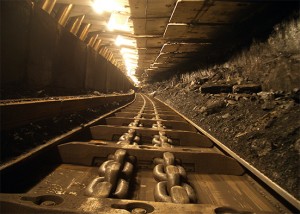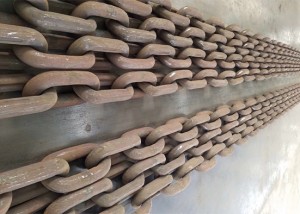How to Pairing, Installation and Maintenance the Mining Flat Link Chains?
As a round steel link chain manufacturer for 30 years, we're glad to share the ways of Pairing, Installation and Maintenance the Mining Flat Link Chains.
1. Product Features
Mining high-strength flat link chain has the characteristics of large bearing capacity, strong wear resistance, good impact toughness and long fatigue life.
2. Main Purpose and Scope of Application
It is widely used in Armored Face Conveyor (AFC) and Beam Stage Loader (BSL) in coal mine.
3. Executive Standard
MT / t929-2004, DIN 22255
4. Pairing and Installation
4.1 Flat link chains pairing
The accurate pairing of mining flat link chains is essential for the successful operation of the conveyor. When the chain leaves the factory, it is paired with one-to-one chain links to ensure that the scraper is in a straight line and the stability of the scraper in the middle groove. Place the paired flat link chains in a packing box and attach a label to each paired chain. Paired chains shall not be used separately. Pairing tolerance refers to the maximum allowable length of any pairing chain.
4.2 Flat link chains installation
The paired flat link chains are correctly assembled on the scraper to optimize the performance of the chain. This will ensure that the tolerances on both sides of the chain are minimized and that the chain tension is effectively controlled when the scraper conveyor is initially started. Ensure a good straight face and minimize the difference of pretension.
The chain is installed in pairs, and the long paired chain and short paired chain are assembled in turn. New sprockets and baffles are usually assembled when installing new flat link chains.
Make sure that the flat link chains do not run when it is first installed without lubrication guarantee. If it runs without lubrication, the chain link will wear quickly.
Ensure that the correct tensioning process is suitable for scraper conveyors and transfer machines. Check the pre tension every day in order to create a suitable tension value for each chain. Because the chain itself and its cooperation with the conveyor need to be run in place, the first few weeks of equipment operation are very critical.
5. Flat Link Chains Maintenance
5.1 Operations
Scraper conveyor chains, scrapers and chain connecting links (connectors) are consumables, which are easy to wear and damage when reused. Therefore, flat link chains maintenance is very important to prolong the service life of the chain and ensure the minimum risk of chain failure.
Maintain the straightness of the working surface as accurately as possible.
If the working face is not straight, it can cause different degrees of wear and elongation of the chain.
The bending angle at the rear of the shearer is minimized. If it is too tight, it will increase the required power and chain wear.
Implement chain management procedures to ensure that all operations are trained and best practices are achieved under the guidance of the conveyor manufacturer, follow the procedures, maintain and keep records.
5.2 Maintenance recommendations
In some coal mines, the maintenance practice of the flat link chains is mainly the operator's confirmation of the chain pretension, which can well control the chain performance. Because the condition of reducing the strain rate is an important factor to prevent the early failure of the chain. The following is a summary of some key points, and the suggestions put forward by the conveyor manufacturer must be implemented.
- Check the pre tension every day, especially two or three weeks before the new installation and operation of the chain.
- Check the conveyor chute before starting to ensure that there are no obvious defects or problems.
- Replace the damaged scraper and chain link as soon as possible.
- Remove any damaged or broken chains and check the elongation of adjacent chains. If it does not meet the requirements, it should be removed in time. If the chain is worn, the chains on both sides must be replaced at the same time in order to maintain the pairing of the chain.
- Check damaged chains, baffles and sprockets and replace them if necessary.
- Inspect the scraper for loose, missing and damaged attachments.
- Check the chain for wear and elongation. Because wear or elongation inside the link (indicating overload) or both will lengthen the chain.
When the flat link chain is overloaded and stretched, it is obvious that there is deformation, resulting in a natural increase in the overall length of the chain link. This may affect the number of adjacent links, resulting in chain mispairing. In this case, the affected part shall be replaced, and if the chain is worn, the chains on both sides shall be replaced at the same time to maintain the pairing of the chains.
- generally, the chain is elastically stretched and will return to the original pitch after unloading. The internal wear of the link will increase the pitch of the chain, the external dimension of the link will not change, but the overall length of the chain will increase.
- it is allowed to increase the chain pitch by 2.5%.
6. Flat Link Chains Transportation and Storage
a. Pay attention to rust prevention during transportation and storage;
b. The storage period should not exceed 6 months to prevent corrosion and other factors from reducing the service life.
Post time: Sep-06-2021


